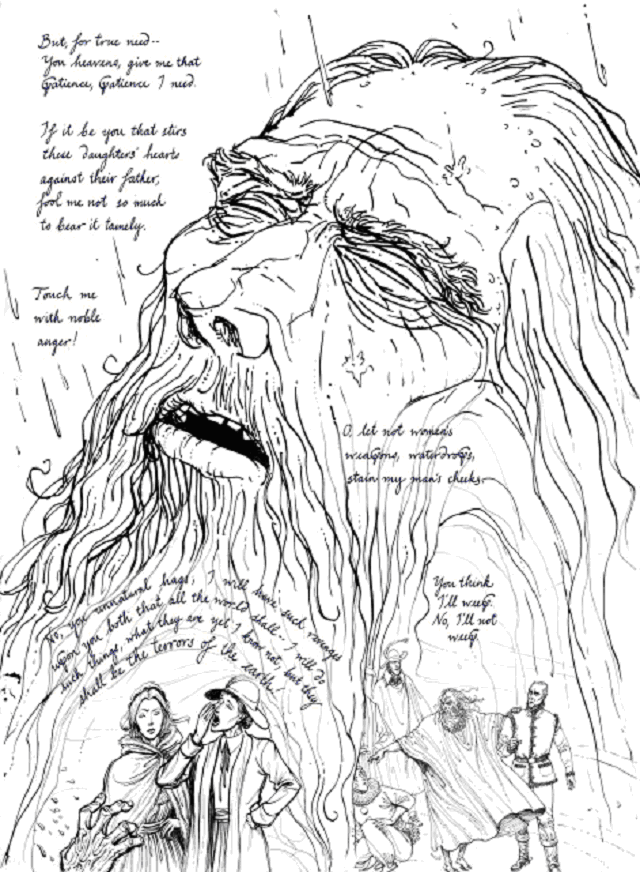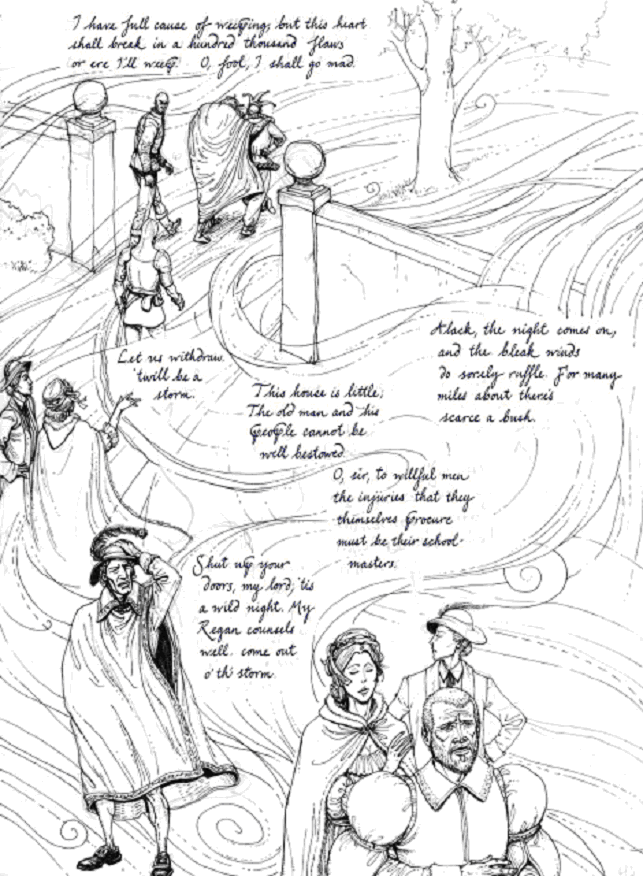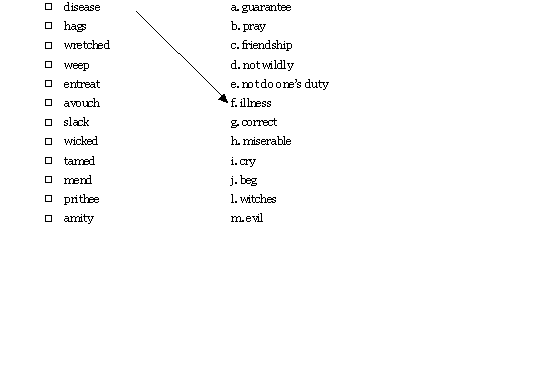|
The Point of No Return
PERIODS 9-10
Text eight: “I pray you, father, being weak, seem so” (Act 2, Scene 4, ll. 196-280)
BEFORE READING ACTIVITIES
1) WHAT HAPPENS TO LEAR (15 min. including oral check)
AIM: To focus on Lear as a complex tragic hero, to resume his disastrous actions of I.1 that will
lead to punishment, isolation, catharsis and reconciliation. The use of comic strips should make the issue of Lear more accessible to a young audience. PROCEDURE: The teacher gets the class to work in pairs and hands out the comic below (one per pair). Students are expected to resume the story of Lear through the steps given in the comic. Before doing the activity, it might be useful to teach them new vocabulary such as:
Demesne: land, property
Prowess: expertise
Betrothal: engagement
I’ faith: in faith
Upbringing: education
Read the comic strip and resume Lear’s story

KEYS
1) Lear is old and wants to retire. 2) He divides is kingdom according to a ‘love-test’. 3) He discovers he has made a big mistake, and now he has no daughters and no place to go. 4) He recognizes his error but it is too late. 5) The Fool points out the King’s folly for having divided his kingdom. The French army is on the way. The Fool leaves the king to his fate. 6) The king realizes he is alone.
2) THE POINT OF NO RETURN (20 min.)
AIM: To focus on the issue of Lear’s identity and his descent into madness. PROCEDURE: The teacher hands out the illustrations below (one copy per pair) and asks his/her students to make predictions about what they are going to read. Students work in pairs for fifteen minutes, then the teacher gets an oral feedback.
Look at the illustrations, then answer the following questions
1.Physical or emotional suffering comes before ‘madness’ and is a cause of it. What suffering is cause of Lear’s madness?
2.Lear calls his daughters “unnatural hags”. What do you think they have done to deserve this title?
3.Who does he address his words: “I shall go mad”? Why?
4.While Lear pronounces these words, there is a deterioration in the weather, with strong winds, rain and thunder. How would you describe this weather? What do you think it may symbolize?
5.Becoming insane is often a metaphor for changing the way you look at yourself and the world. What will King Lear learn?
6.At the end of Act II, Lear is locked out of the castle. Who locks him out of the castle? Who remains with the king?
7.How would you judge children who lock their old fathers out of the house?
KEYS
1.Physical and emotional distress due to recent familiar events.
2.They must have revealed themselves as they really are.
3.The Fool. Since he is loyal to the king, he deserves such confidence.
4.A storm. His state of mind.
5.Students may give different answers. Possible answer: King Lear will learn more about his life and life in general. He will also learn that the people who stay true to him are the people who love him most. In other words, he will realize his mistake of trusting flattery over honesty.
6.His two daughter Gonerill and Regan. Kent (disguised as Caius) and the Fool.
7.Students give their personal responses.
At the end of pre-reading activities 1-2, students are provided with a copy of the synopsis below.
SYNOPSIS (silent reading,5 min.)
Reaching old age and desiring a quiet life without the responsibilities and cares of state, King Lear decides to divide his kingdom between his three daughters, Gonerill, Regan and Cordelia. He devises a ‘love-test’ to see which daughter loves him most, expecting his favourite youngest daughter Cordelia to ‘win’ and claim the largest share of the kingdom. Cordelia thwarts his plan, refusing to take part in the ‘love-test’. Furious, Lear casts her off and divides the kingdom between Gonerill and Regan. Cordelia marries the King of France, and leaves Britain. Gonerill and Regan decide to rid themselves of their tiresome father once and for all, and plot against Lear. They drive him out into a storm and shut the doors against him. Alone on the heath except for two faithful servants (Kent and the Fool) and a counterfeit mad beggar (Poor Tom), Lear goes mad. Meanwhile, his friend the Earl of Gloucester has also been treated treacherously by his illegitimate son Edmund, who has duped him into believing his legitimate son seeks his life. Attempting to help Lear, Gloucester incurs the wrath of Lear’s daughters and is blinded as a punishment. Learning from letters of her father’s plight, Cordelia returns to Britain with the French army. She intends restoring Lear to his throne. Lear and Cordelia are reunited at the French camp in Dover. The French army loses. Lear and Cordelia are imprisoned by Edmund. Gonerill and Regan have both been rivals for Edmund’s love, and their lust drives the sisters to desperate behaviour. Gonerill poisons Regan and then kills herself. Meanwhile Edmund has ordered Lear and Cordelia’s deaths. In spite of the efforts of Gonerill’s husband Albany to save them, Cordelia is hanged in prison. Her death is too much for Lear, who has come to a greater understanding of himself and others through his madness. Lear dies a broken man, half mad.
Illustration 1

Illustration 2

3)REASON NOT THE NEED (25 min.)
AIM: To enhance our understanding of the text and appreciate different versions of one of the most famous speeches of the play. PROCEDURE:
Classroom task:
1. Cue up three different videos/dvds to Lear's speech "Reason not the need" (or, if you are in a computer lab and have a broadband connection, open the links provided in this unit).
2. Divide the class into 6 groups. Each group will focus on a different aspect:
- Group 1 will follow the script in their texts and make a note of cuts and edits;
- Group 2 will make a note of the use of music/sound effects in the scene;
- Group 3 will be asked to comment on set/costumes/props/furniture;
- Group 4 will make a note of staging (movement, relationships, eye contact, focus etc);
- Group 5 will talk about Lear and the Fool;
- Group 6 will talk about the daughters;
3. Watch first film version
4. Discuss answers
5. Repeat for second and third versions
6.Discuss the different ways directors realise Lear's speech in the 3 versions
7. Discuss what was successful and why
8. Analyse what didn't work in production (if anything).
To watch these clips, a broadband connection is required. Clips are real media. They belong to different productions: Ian Holm 1998, Lawrence Olivier 1984, and James Earl Jones 1974.
WHILE READING ACTIVITY
LEAR’S HUNDRED KNIGHTS (25 min. including oral check)
AIM: to focus on the issue of Lear’s hundred knights, to give students a purpose for reading, to guide them towards a deeper understanding and an appreciation of the text. PROCEDURE: Students continue to work in pairs. They are given one copy of the handout below and they are asked to answer a set of comprehension questions. They work for fifteen minutes, then they share their answers with their classmates (peer correction).
Explore what leads up to Lear’s frenzied “O, reason not the need!” speech. Read the text, then answer these questions.
1.How do Gonerill and Regan assert power over their father, thus driving him into a raging storm?
2.What is the importance of all that arguing about the need for a certain number of servants?
3.Why does Lear go mad at last?
KEYS
1.By denying their father his retinue.
2.The dismissal of Lear’s knights is significant for a number of reasons. His followers are a symbol of Lear’s might and importance, but they also represent real fighting power. With only the support of a few old men, Lear will not be able to assert himself or regain control of the kingdom.
3.Because he is unable to tolerate how impotent he has become.
REGAN
I pray you, father, being weak, seem so .
If till the expiration of your month,
You will return and sojourn with my sister,
Dismissing half your train, come then to me:
I am now from home and out of that provision
Which shall be needful for your entertainment .
LEAR
Return to her, and fifty men dismissed!
No, rather I abjure all roofs, and choose
To wage against the enmity o' the air ,
To be a comrade with the wolf and owl,
Necessity's sharp pinch! Return with her?
Why, the hot-blooded France, that dowerless took
Our youngest born, I could as well be brought
To knee his throne, and, squire-like , pension beg
To keep base life afoot. Return with her!
Persuade me rather to be slave and sumpter
To this detested groom .
He points to Oswald
GONERILL
At your choice, sir.
LEAR
I prithee , daughter, do not make me mad:
I will not trouble thee, my child. Farewell.
We'll no more meet, no more see one another.
But yet thou art my flesh, my blood, my daughter –
Or rather a disease that's in my flesh,
Which I must needs call mine. Thou art a boil,
A plague-sore, an embossed carbuncle ,
In my corrupted blood. But I'll not chide thee;
Let shame come when it will, I do not call it.
I do not bid the thunder-bearer shoot ,
Nor tell tales of thee to high-judging Jove.
Mend when thou canst; be better at thy leisure;
I can be patient; I can stay with Regan,
I and my hundred knights.
REGAN
Not altogether so.
I looked not for you yet, nor am provided
For your fit welcome. Give ear, sir, to my sister;
For those that mingle reason with your passion
Must be content to think you old , and so--
But she knows what she does.
LEAR
Is this well spoken?
REGAN
I dare avouch it, sir. What, fifty followers?
Is it not well? What should you need of more?
Yea, or so many, sith that both charge and danger
Speak 'gainst so great a number? How in one house
Should many people, under two commands
Hold amity ? 'Tis hard, almost impossible.
GONERILL
Why might not you, my lord, receive attendance
From those that she calls servants or from mine?
REGAN
Why not, my lord? If then they chanced to slack ye ,
We could control them. If you will come to me,
For now I spy a danger, I entreat you
To bring but five-and-twenty; to no more
Will I give place or notice.
LEAR
I gave you all--
REGAN
And in good time you gave it.
LEAR
Made you my guardians, my depositaries ;
But kept a reservation to be followed
With such a number. What, must I come to you
With five-and-twenty – Regan, said you so?
REGAN
And speak't again, my lord; no more with me.
LEAR
Those wicked creatures yet do look well-favoured,
When others are more wicked. Not being the worst
Stands in some rank of praise. (To Gonerill) I'll go with thee.
Thy fifty yet doth double five-and-twenty,
And thou art twice her love.
GONERILL
Hear me, my lord;
What need you five and twenty, ten, or five,
To follow in a house where twice so many
Have a command to tend you?
REGAN
What need one?
LEAR
O, reason not the need ! Our basest beggars
Are in the poorest thing superfluous .
Allow not nature more than nature needs –
Man's life is cheap as beast's . Thou art a lady:
If only to go warm were gorgeous,
Why, nature needs not what thou gorgeous wear'st
Which scarcely keeps thee warm . But, for true need-
You heavens, give me that patience, patience I need!
You see me here, you gods, a poor old man,
As full of grief as age; wretched in both.
If it be you that stirs these daughters' hearts
Against their father, fool me not so much
To bear it tamely; touch me with noble anger,
And let not women's weapons, water drops,
Stain my man's cheeks. No, you unnatural hags !
I will have such revenges on you both
That all the world shall-I will do such things-
What they are yet, I know not; but they shall be
The terrors of the earth! You think I'll weep.
No, I'll not weep.
I have full cause of weeping;
(storm and tempest)
but this heart
Shall break into a hundred thousand flaws
Or ere I'll weep. O fool, I shall go mad!
AFTER READING ACTIVITY
SPOTLIGHT ON LANGUAGE (10 min. including oral check)
AIM: To guide students toward a deeper understanding of the text. PROCEDURE: The teacher hands out the following activity. In pairs, students match the words below to the correct definitions. After ten minutes, the teacher provides a correcting feedback.
Match the words below to the correct definition. The first one has been done for you.

KEYS
2. l – 3. h – 4. i – 5. j – 6. a – 7. e – 8. m – 9. d – 10. g – 11. b – 12. c
 9/11
9/11

|